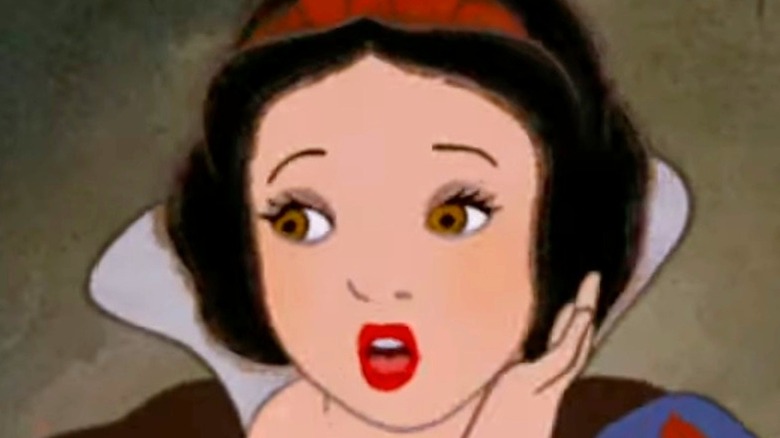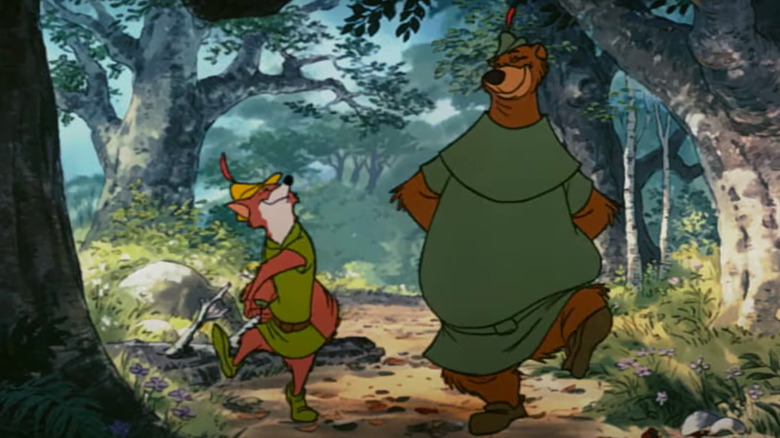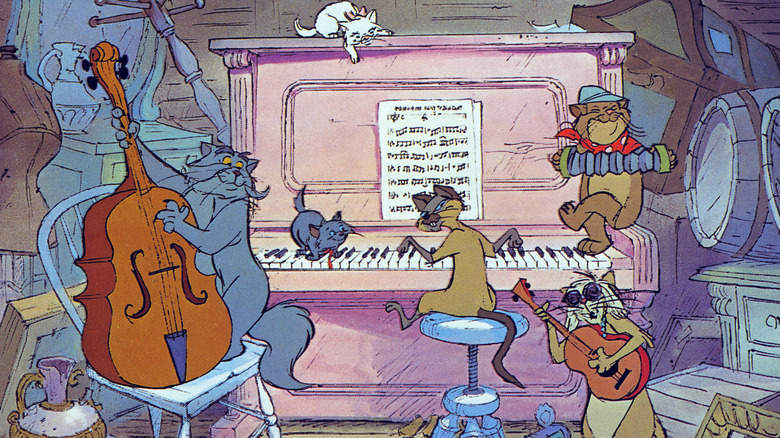The Classic Disney Movie That Obviously Reused Animations
The Walt Disney Company has built an empire out of retelling classic fairy tales and fables, using colorful animation, endearing characters, and innovative storytelling to make age-old stories palatable for audiences worldwide. "Snow White and the Seven Dwarfs," often listed as one of the best Disney movies of all time, was Disney's first animated feature film, released in 1937. As the first full-length film to be produced using cel animation, "Snow White and the Seven Dwarfs" was also the first of many hits for the company (via National Museum of American History).
The animation work from some of those early films was so innovative that it was later reused in the creation of another well-known Disney flick. In fact, certain scenes from "The Jungle Book," "Snow White and the Seven Dwarfs," and "The Aristocats" helped to round out a key sequence in Disney's version of a classic English folktale. Sharp-eyed viewers can see character motions — and sometimes entire frames — from the earlier movies transplanted into another film, though obviously adjusted for the new settings and characters. But which Disney film got a little help from the art of previous animations?
Robin Hood reused animation from several Disney films
"Robin Hood" is the bandit in question. The legendary Robin Hood — reimagined in Disney's version as a wily fox — is an outlaw who steals from the rich to give to the poor, which is fitting, given that the film's animators borrowed animation from other Disney hits in order to finish this fanciful adaptation.
Much of the reused animation is utilized during a scene when the characters gather in Sherwood Forest to sing "The Phony King of England." As detailed in a side-by-side video from FilmIsNow, you'll see that Maid Marian's dance with her other forest friends lines up perfectly with Snow White's dance with Dopey and Sneezy from "Snow White and the Seven Dwarfs." A few moments of Duchess and Thomas O'Malley's dance from "The Aristocats" and Marian and Robin's dance in "Robin Hood" also have the same movements. Additionally, Little John (in the form of a happy-go-lucky bear) is clearly modeled after Baloo from "The Jungle Book"; the characters even share a voice actor (via IMDb). His dance with Lady Kluck mirrors the animation used in Baloo's dance with King Louie during "I Wan'na Be Like You."
It's pretty impressive that the animators were able to repurpose the animation from scenes in other films, which contributed to "Robin Hood" being one of the lowest-budgeted films Disney ever produced (via LADbible). Unless you watch the footage side-by-side, you'd probably never notice. The film remains a fan favorite almost fifty years after its release, with high audience marks on Rotten Tomatoes. It helps that Robin Hood and Little John have one of the greatest friendships in Disney film history.
But how did this process of reusing bits of animation get into the film? It turns out that the use of recycled motion came down to someone who was very familiar with the practice.
Wolfgang Reitherman reused animation in several films
The sequence switcheroos were made possible by animator and "Robin Hood" director Wolfgang "Woolie" Reitherman — at least, according to former Disney animator Floyd Norman, who worked alongside Reitherman on projects like "Robin Hood," "The Jungle Book," and "The Sword in the Stone." Norman maintains that animation was reused not because of budget or time constraints, but because Reitherman preferred it that way.
"It's actually harder and takes longer to redraw an existing sequence," Norman confirmed to GeekDad. "It's a lot faster and easier to just do new animation, and it's a lot more fun for the animators. But Woolie liked to play it safe and use stuff he knew would work. That's all it was."
It seems like Reitherman had the attitude of "if it's not broken, don't fix it" when it came to animated film production. He directed many of the Disney films that made use of recycled animation, including "The Jungle Book," "Robin Hood," "The Sword in the Stone," "101 Dalmatians," and "The Aristocats" (via IMDb), as seen in FilmIsNow's comparison video. Regardless of Reitherman's reasoning for using this technique in so many films, it was only one small part of his accomplishments — he ultimately gave us a whole host of Disney classics, several of them still ranking near the top of the list of the best Disney films, according to critics (via Rotten Tomatoes).


